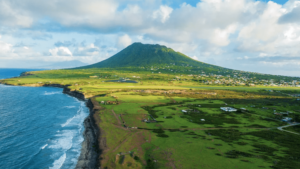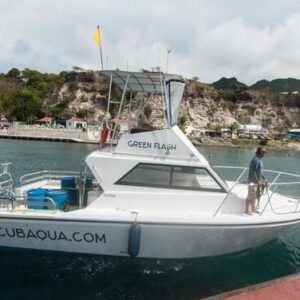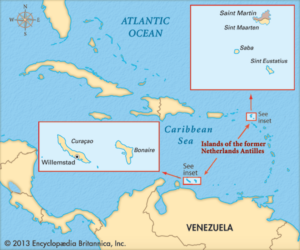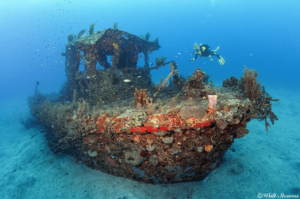Intricate Landscapes/Historical Dives
Saint Eustatius (Sint Eustatius), lovingly called Statia, offers visitors history, nature, and adventure. This low-key island with lush, stunning landscapes has never hosted a cruise ship or a beachfront condominium. Located on the northern Leeward Islands, Statia boasts unparalleled old-world charm both above the waters and below. Diving enthusiasts will enjoy a haven full of incredible marine life and a rich history. From shallow, pristine reefs to deep walls and boulder labyrinths, there is plenty for divers to explore. Most of the 36 moored diving sites are within three miles of the shore which provides calm water conditions and clear visibility. Divers who venture further from the shore will experience intriguing landscapes formed during volcano eruptions. Dives include more than 700 species of fish, 8 distinct habitats, 70+ species of hard and soft corals, century-old artifacts from sunken ships including the famous “blue bead” that divers can retrieve from the ocean and keep.

GETTING THERE
Air: Visitors must fly to St Martin’s Princess Juliana Airport (SXM) then take one of five daily flights operated by Winair landing at F.D. Roosevelt Airport (EUX).
GETTING AROUND
Walking: Public transportation is not an option in St Eustatius. There are no traffic lights, and most locals walk to their destinations.
Car and Motorcycle Rentals: Cars and motorcycles are available for rent around the island.
Minibus: Local hotels run daily minibus trips to various sites around the island.
GOOD TO KNOW
Country: Caribbean Netherlands
Time Zone: UTC-4:00
Primary Language: Dutch is the official language. English is widely used and taught in schools.
Currency: USD
Cell Phone Service: Roaming fees apply.
Voltage: 110V/220V Plugs A, B, C, F
Passport and Visa: A passport is required that is valid at least 3 months beyond the date of entry into the country. The island requires a return airline ticket and proof of hotel confirmation. A departure tax of $15 per person is required when leaving the island.
Hurricane Details: June-October
DIVE CONDITIONS
Water Temperature: 79-82 degrees F
Water Visibility: 60-200 feet
When to Go: Dry season is from January-June.
Diving Difficulty: Beginner-Advanced
TOP DIVE SITES IN SAINT EUSTATIUS
Saint Eustatius caters to the diving enthusiast! Listed are some of the very best that this island can offer divers:
- Charles L. Brown Wreck is one of the largest wrecks in the Caribbean. This 320-foot AT&T Transatlantic cable-laying ship was built in 1954. Thrill-seekers will enjoy the ship’s interior. Above the wreck, divers will spot barracudas including Charlie the massive barracuda resident. Deep sea fans and sponges cover the ship’s deck. Around the ship, divers will enjoy angelfish, sea turtles and copious quantities of yellow-headed jawfish.
- Drop Off is a reef wall dive reaching a depth of 130 feet. Advanced divers will enjoy exploring the deep lava flows covered with sea fans.
- Double Wreck is not a wreck dive but a historical reef dive at 60 feet. The dive features the remains of 300-year-old sunken ships. The remains include two huge anchors and a dozen ballast stones covered with sponges and coral. Divers will spot large southern stingrays that guard the dive site. The ballasts make a home for huge families of tiny blennies. Cleaner shrimp can be seen at many cleaning stations and seahorses, frog fish and turtles can be spotted here.
- Cliffs is an advanced diving site with an impressive drop off and located along the southern side of Statia. At 130 feet, this deep dive includes black coral, deep sea fans and wire coral. Divers will have the opportunity to have close views of yellow headed goby and schooling creole wrasse. The hard-to-find lettuce sea slugs and trigger fish can be found here.
- Shark Reef is located on the northern side of Statia and is an advanced dive due to the depths and strong currents. Here, divers will have up-close interactions with reef sharks.
- Aquarium is a 60 feet reef dive located on the north side of Statia. Surrounded by a large area of sand and sea grass, this site is a lava bomb of coral and sponges. Hundreds of sergeant majors can be spotted here as well as turtles, scorpion fish, moray eels, garden eels and hordes of lobsters.
- Blair Reef is a 62 feet reef dive of underwater coral named for the local Statia angler, Sinclair Blair. This site is a macro heaven on the north side of the island and home to lobsters, seahorses, barracuda, juvenile smooth trunkfish, and spotted drum fish.
- Blue Bead Hole is a 55 feet historical muck dive that dates to the 17th The blue beads, which are considered lucky, can be found here and are the only artifact that divers are allowed to take from the waters. The blue beads are said to be found here after being thrown in the ocean by slaves celebrating their freedom in 1863. Located on the southern corner of the island, Blue Bead Hole offers a mix of coral heads and sea grass which is home to pike, tailfin blennies, scorpion fish and mantis shrimp. Divers will enjoy spotting the most sought-after fish around the island, the flying gurnards.
- Barracuda Reef is a long, three mooring reef wall dives at 72 feet full of cracks and overhangs with an abundance of coral, sponges, and marine life. This dive is famous for the number of barracudas and nurse sharks found here. The cracks in the wall are occupied by lobsters. This site hosts the largest concentration of queen angelfish. If the current provides, this site can be a drift dive.
- Hangover is a colorful labyrinth of ancient lava at a depth of 55 feet. The overgrown and healthy coral and sponges are home to yellow head jaw fish, peacock founders and queen conch. Caribbean reef sharks, yellow tail damselfish and angel fish can be spotted here.
- Anchor Point is named for the French anchor from the 1700s that was hooked in the surrounding reef. At 60 feet, this site is considered one of the most beautiful dives on the island. Divers will enjoy swim throughs while observing cleaning stations with Spanish hogfish. From the top of this reef, divers will enjoy the barrel sponge forest with many different coral species including tube sponges. The cracks and overhangs of this dive contain drum fish and lobsters. Caribbean reef sharks can be found here as well as varied species of moray eels. Divers may even spot the elusive sharp tail eel.
- The Grand Canyon is in the southwest area of the island. This 130-foot wall dive is suited for advanced divers. Divers are offered a chance to explore the narrow cracks from the steep lava flows and canyons. The walls are covered with deep sea fans, wire coral which house hundreds of lobsters. Pelagic species such as Caribbean reef sharks and spotted eagle rays can be observed at the Grand Canyon.
- Chien Tong Wreck is a Taiwanese extensive line fishing trawler sunk in 2004 at 80 feet. This 170-foot vessel was sunk as an artificial reef on the bottom of Orange Bay and full of marine life. The vessel sits upright and is home to horse-eyed jack, barracuda, and southern stingrays. This site is perfect for night diving where divers can enjoy green and hawksbill turtles.
- Stenapa Reef is a unique, 60-foot wreck dive located close to Chien Tong. This barge is attached to the mooring which is covered with sponges that have taken over the deck. Divers will enjoy exploring the wheelhouse full of yellow sponges and orange cup coral. Massive garden eels, octopus and southern stingrays can be found in the sandy areas.
- The Humps is a 52-foot reef dive suited for both beginners and advanced divers. The site was named after the gigantic lava bombs and lava fingers covered in coral found here. Macro divers will spot pike bennies, orange sided gobies and decorated neck crabs.
- Gibraltar is a 65-foot reef wall dive in the far north of the island where the Atlantic meets with the Caribbean Sea. Divers will maneuver over enormous boulders where sharks can be spotted.
TOP ATTRACTIONS IN SAINT EUSTATIUS
- The Quill/Boven National Park is located on the south side of the island. The dormant volcano, the Quill, is within Boven National Park. Standing 2000 feet above the island, visitors can explore the crater inside the volcano. Eight trails lead hikers to the top of the volcano and end at Mazinga Peak offering 360-degree views of the island. Hikers will see native flora and sculptures by local artists.
- National Marine Park surrounds the entire island. Two reserves, one north and one south, within the park were created in 1996. These areas are mandated as no fishing and no anchoring sites which allows for the area to host perfect condition coral reefs.
- Zeelandia is a 2-miles black sand beach located along the Atlantic coast. The waters here have an undertow that makes it dangerous for swimming but is a perfect landscape for pictures.
- Miriam C. Schmidt Botanical Garden was created for the community to cultivate native and tropical plants. Founded in 1999, the garden is located on the southern slope of the Quill and a perfect place to enjoy the island’s nature.
- Oranjestad is the island’s capital city. Visitors can walk the quaint cobblestone streets where shards of ancient pottery and bottles can be found.
- The Old Gin House is a beautiful hotel and bar located in Lower Town. Once a 1760 public guest house and then in the 18th and 19th century a cotton factory, visitors will appreciate the history and beauty the Old Gin House offers.
- Fort Oranje is in Upper Town and overlooks the harbor with fantastic views of Saba. On November 16, 1776, the famous welcome salute was fired from Andrew Doria. The US naval vessel flew the flag of the 13 rebellious colonies. Statia was the first country to recognize the independence of United States of America. The fort hosts the tourist office and government offices.
- Battery de Windt was abandoned in 1815 and served as a defensive structure of Statia. Visitors can observe the stone battery as well as two cannons. From the fort there are breathtaking views of the island and St Kitts.
- Honen Dalim Synagogue meaning charitable to the poor is a Jewish monument erected in 1738. The Netherlands shipped the beautiful yellow stones used to build this important Jewish building.
- St Eustatius Historical Foundation Museum is located inside the Simon Docker house in the center of Upper Town Oranjestad. This house is one of the oldest and most beautiful houses on the island and is a perfect example of how the upper class lived over three centuries ago. The rooms host mahogany furniture, historical artifacts, and ceramics.
History comes alive both above and below the waters in St Eustatius nicknamed “historical gem.” The island is home to more colonial period history than anywhere else in the world. Once the busiest trading port in the Caribbean during the 18th century, it stands as one of the least touristy islands today. Among the scuba diving community, Statia is known for its variety of dive sites containing both shallow and deep sites filled with unrecognizable historical and modern wrecks, lava formations in corals and an abundance of marine life. St Eustatius is an island where time stood still and offers divers an unforgettable underwater exploration.








